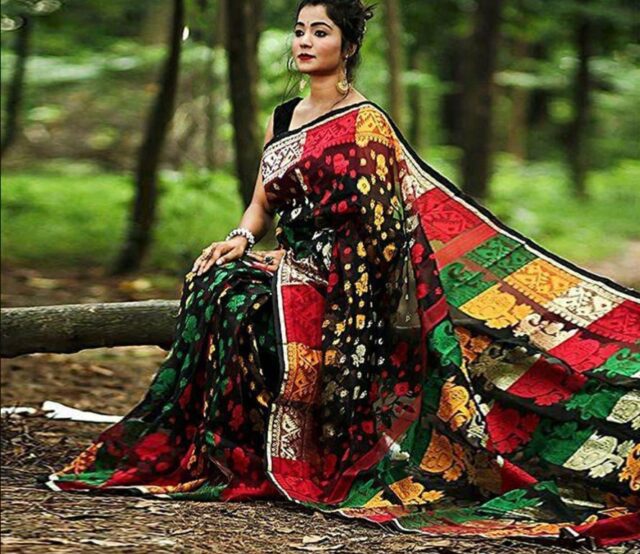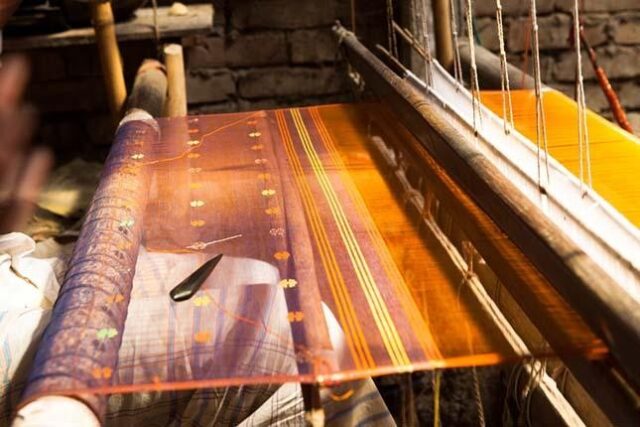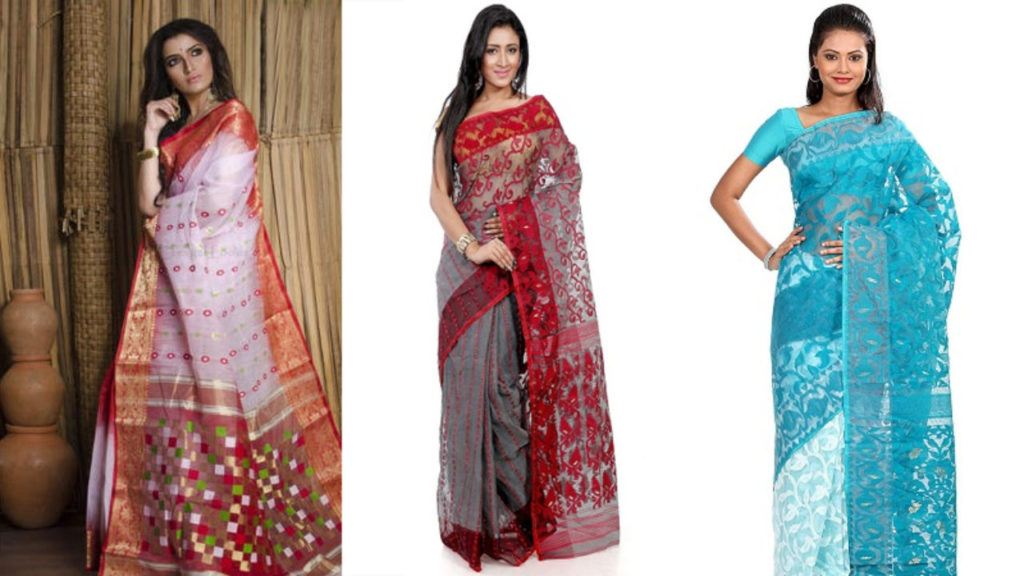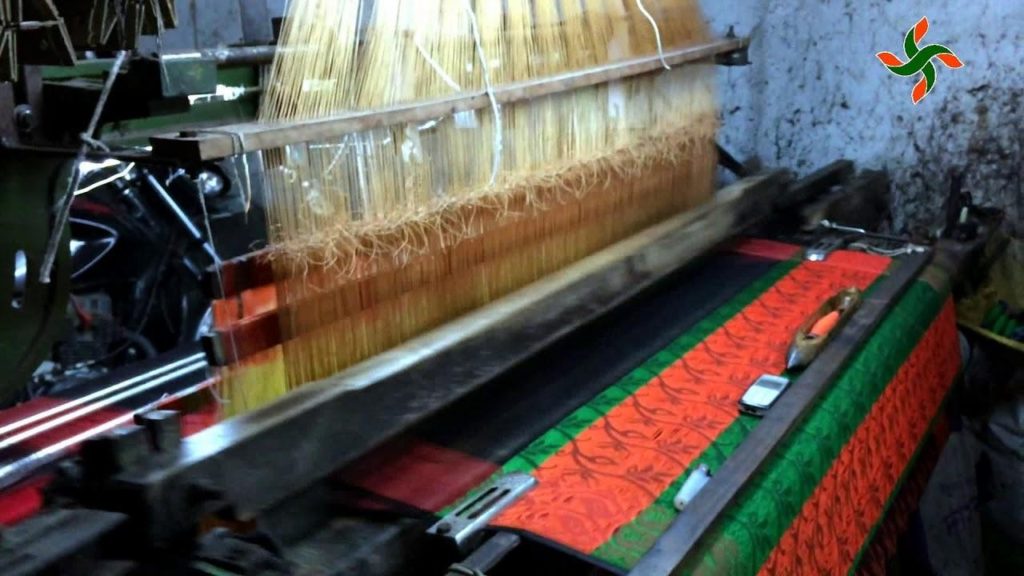
When you hear the word ‘Bengal’, you might think about sweets and fish, in addition to the saree making industry, that is fully thriving, in this region of India. All women in the country consider sarees to be a very important aspect of their wardrobe, and Jamdani is among these – it also boasts a unique heritage that is not found with the other saree types. Also known as Dhakai or Dhakai Jamdani, this form of weaving has its roots in the Bangladesh town of Dhaka.
The word ‘Jamdani’ in itself is a derivative of the Persian words ‘jam’ meaning flower, and ‘dani’, meaning ‘vase’. The weaving process is usually a time consuming one and is done on brocade, and the final product features motifs of flowers and different figures. The cloth itself is not entirely silk, unlike many other types of sarees throughout India – instead, it is a muslin cloth, and also features a mixture of gold and cotton threads.
The History
Because of the name Jamdani, the saree suggests a Persian origin and a very strong influence from the Mughal Empire (from the 16th to 17th Centuries). The name itself suggests that the saree has intricate flower motifs that adorn it. On the other hand, the Bengali version of its name is Dhakai, which reveals the place of its origin – Dhaka.
Mentions of these sarees go back centuries before, even as far back as the third century BCE, according to Chanakya’s Arthashastra. There are also accounts of it in records of Chinese, Italian, and Arab traders and travelers, as well as the Periplus of the Erythraean Sea. Later, in the years of the 19th Century, the fabric acquired a new name thanks to TN Mukharji – Jamdani muslin.
Even though the fabric had enjoyed widespread popularity from its beginning, its production peaked during the years of the Mughal Empire. It experienced a decline during the British colonial years due to imports from cheaper yarn from European countries, and also due to the decline of the Mughal Empire around the same period. In fact, this time even saw the decline of many villages that had once thrived on the Jamdani industry such as Jangalbadi and Madhurapur – although a small community of weavers continued to make the fabric.
The Weaving Process

Just like all other traditional arts, the weaving process is carried out by men. There are some communities in the regions of West Bengal and Uttar Pradesh in India, as well as Bangladeshi towns like Shiddhirganj and Sonargon that continue to carry out this skill.
The base fabric is usually unbleached cotton yarn, while the designs are in bleached cotton – this creates a light and dark effect. The process is very time consuming though because the hand-looming process is tedious.
The making uses standard weft technique with supplementary weft techniques. Using the standard one, the base material is made, and then the weaver manually adds thicker weft threads through the supplementary weft motif, using very fine bamboo sticks and individual spools. At the end of the process, the fabric will have exciting patterns that appear as though they are floating on the surface – this is actually the distinguishing factor of Jamdani sarees.
The whole process is like a tapestry, because the weaver passes silver, gold or colored threads throughout the weft as they work. There are different designs as well; they range from the jhalar, or flower motif networks, to the butidar (the whole saree has floral spray designs) and the tercha (the floral sprays are diagonal). However, the pricing constraints of today have forced many weavers to simplify their designs.
An interesting thing to note about the amazing motif designs is that the weaver does not decide on them before they work, and they do not sketch them on the fabric. What they do instead is drawing the design on a translucent graph paper, then place the paper under the warp.
Unique features of the design

It is not surprising to find out that Jamdani sarees are expensive – after all, the process that is used to make them is time-consuming and labor-intensive. This is also because of the motif designs, which the weaver creates directly on the loom through the discontinuous weft method.
The motifs are created using silver and gold threads, all through the standard weft technique. this allows them to add complexity to the designs as needed.
Because of their translucent and delicate nature, they are very soft to the touch and drape very well. They usually feature floral or multicolored motifs, such as the ever-popular mango motif (this signifies marital bliss and fertility). Different sarees have their own unique aspects – these include the Shantipur Jamdanis that have delicate stripes or checks that are made from a mixture of thick and fine yarn or multi-colored threads and Tangail Jamdanis that have a ‘meenakari’ effect due to their single or dual colored borders.
The motifs include thousand emeralds, or penna Hajar, fuller (flowers that are arranged in a straight row), kalka (paisley), jalar (motifs that cover the whole saree evenly), butidar (small flowers), tersa (diagonal patterns), charka (rectangular motifs), and duria (polka dots). You will even find these designs in other items such as handkerchiefs and scarves.
What are the varieties of Jamdani?

Each region that the Jamdani originates from will have its own distinct production variation. If you would like the original quality of Jamdani sarees, for instance, you have to look at Dhakai Jamdani that originates from Bangladesh – they have the most intricate levels of workmanship. In fact, their weaving process takes between six months and a year and can feature other motifs such as fish scale, lotus, and lamps.
Tangail and Shantipur Jamdanis are very similar as they have fine textures and beautiful motifs. On the other hand, the Dhaniakhali Jamdani has tighter weaving, dark contrasting borders, and bolder colors.
Final thoughts
The Jamdani saree is well known for its high quality and great texture, making it very popular among many. You can check out some beautiful designs at StyleCaret. These sarees worth having as part of your collection.








